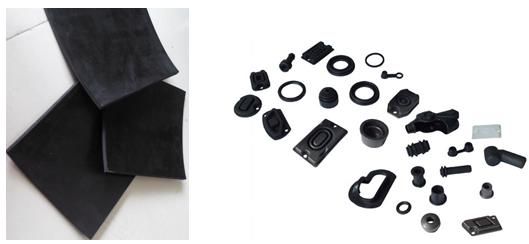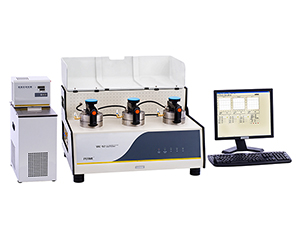Abstract : As one of the greenhouse gases, sulfur hexafluoride gas in electrical products can cause air pollution and endanger the normal operation of electrical equipment and people's health. Therefore, an effective method must be used to monitor the barrier properties of materials used in electrical products for sulfur hexafluoride gas, such as the gas permeability coefficient and the amount of permeation. This article uses the VAC-V2 Differential Pressure Gas Permeameter independently developed by Jinan Languang Electromechanical Technology Co., Ltd. to test the barrier properties of a certain brand of rubber material samples, and details the test principle and the detection process so as to monitor the product for harmful gases. The hermetic properties provide a valuable reference. Keywords : high-voltage electrical appliances, high-voltage switches, insulating materials, rubber, greenhouse gases, sulfur hexafluoride gas, barrier properties, tightness, permeability, permeability coefficient, permeation, differential pressure gas permeameter 1 , the meaning Sulfur hexafluoride (SF6) gas is one of the six greenhouse gases currently discovered. Its effect on the greenhouse effect is 25,000 times that of carbon dioxide , and its life in the atmosphere is about 3,400 years. More than half of the SF6 gas produced annually in the world is used in the power industry, and in particular, the high-voltage switchgear industry accounts for more than 80% of gas consumption . Inappropriate use and management, or failure to recover and regenerate them in the correct way, results in the discharge of sulfur hexafluoride gas and its toxic decomposition products generated by the high-temperature arc or moisture and insulating materials in the equipment into the atmosphere. It causes pollution and damage to the environment in which human beings live, and endangers the normal operation of electrical equipment and people's health. Therefore, how to control the sealing effect of rubber and other insulating materials inside the appliance against internal sulfur hexafluoride is a concern for many electrical appliance manufacturing industries. The barrier property of internal rubber material to sulfur hexafluoride is the most important performance index to characterize the internal greenhouse gas sealing effect. The permeability of rubber to sulfur hexafluoride gas is low (that is, the permeation is low), which shows the barrier property. High, and vice versa. This article uses Labthink 's independently developed VAC-V2 differential pressure method gas permeameter to measure sulfur hexafluoride gas permeability of a rubber sheet used for electrical appliances. By detailing the testing principles, steps and related technical standards, it is relevant to the power manufacturing industry. Industry reference. Figure 1 Electric insulating rubber material 2 , reference standards This test adopts the pressure difference principle to test the permeation performance of sulfur hexafluoride gas, that is, using the differential pressure tester to place the sample between the high and low pressure chambers, vacuuming the low pressure chamber, and filling the high pressure chamber with a certain pressure. Sulphur hexafluoride gas , by testing the change in pressure in the low pressure chamber, to obtain the sulfur hexafluoride gas permeability coefficient and the amount of penetration of the sample, this method has a wide range of test, suitable for high permeability material detection of low gas permeability. At present, the domestic differential pressure test for sulfur hexafluoride gas permeability ( 23 °C standard test environment) test can refer to GB 1038-2000 "Plastic film and sheet gas permeability test method differential pressure method" this national standard. 3 , test sample Insulation rubber sheet (thickness 2.2 cm ) produced by a manufacturer . 4 , test equipment This article uses Labthink blue light VAC-V2 differential pressure method gas permeameter to measure the permeability coefficient and permeation amount of sulfur hexafluoride gas inside the rubber sheet sample. Figure 2 VAC-V2 Differential Pressure Gas Permeameter 4.1 Equipment Principle The device is designed and developed based on the principle of differential pressure, and is divided into upper cavity (high pressure cavity) and lower cavity (low pressure cavity). During the test, the sample is clamped between the two test chambers. First, the vacuum chamber is evacuated, and then the entire system is evacuated. When the specified vacuum degree is reached, the low pressure chamber is closed and a certain pressure is filled into the high pressure chamber. The test gas makes a constant pressure difference between the two test chambers (that is, on both sides of the sample). The test gas penetrates from the high pressure chamber to the low pressure chamber under the pressure difference, and the sample is obtained through the monitoring of the pressure inside the low pressure chamber. Barrier parameters. 4.2 Scope of application (1) This equipment is used to test the permeability (amount), permeability coefficient, solubility coefficient, and diffusion coefficient of various inorganic gases at various temperatures. (2) The equipment can also be extended to aerospace materials, paper and board, paint film, glass fiber cloth, fiberglass paper, cosmetics hose sheet, all kinds of rubber sheet and other materials permeability test. (3) This device is suitable for testing the permeability of many gases, such as nitrogen, oxygen, carbon dioxide, sulfur hexafluoride gas, helium, and air. (4) The equipment meets a number of national and international standards such as ISO 15105-1 , ISO 2556 , GB/T 1038 , ASTM D1434 , JIS K7126-1 , YBB00082003 . 4.3 Equipment Parameters 5 , the test process The highly intelligent VAC-V2 test process is easy: 6 , test results The test results for the sulfur hexafluoride gas transmission rate ( 23 °C , 0%RH ) of the sample are as follows: gas permeability 15.203 cm3/m2·24h·0.1MPa , permeability coefficient 3.9 × 10-14 cm3·cm/cm2·s· Pa . 7. Conclusion The barrier properties of rubber materials to sulfur hexafluoride gas in the related products of high-voltage electrical appliances determine the volume of sulfur hexafluoride gas discharged into the atmosphere, and too much sulfur hexafluoride greenhouse gas can cause air pollution, so it must be strictly controlled. Sulphur hexafluoride gas transmission. In this paper, the blue light Labthink VAC-V2 Gas Permeability Tester for differential pressure rubber insulating material with sulfur hexafluoride gas permeability through the detection of the amount, the test result of the high accuracy and repeatability, and convenient testing process, monitoring appliances may be promptly Product material sulfur hexafluoride gas barrier properties. The packaging performance testing equipment and testing services of Jinan Languang Electromechanical Technology Co., Ltd. covers various aspects such as barrier property, flexibility, impact resistance, puncture resistance, heat sealing performance, sealing performance, solvent residue, evaporation residue, etc. Equipment information and service content You can visit the website of Jinan Languang Company to check or call directly for consultation. The more you understand, the more trust! Labthink is willing to take this opportunity to increase technical exchanges and cooperation with enterprises and institutions in the industry.
Tert-Butyl peroxybenzoate (TBPB) a chemical compound from the group of peresters. It is often used as a radical initiator in polymerization reactions, such as the production of LDPE from ethylene, and for crosslinking, such as for unsaturated polyester resins.
TBPB is a low volatility ,high purity,liquid, aromatic peroxuester.it is effective as medium of a broad spectrum of monomers e.g .styrene.ethylenn,acrylics.it is also used to cure (copolymerzation) unsaturated resins .
TBPB is a clear light yellow liquid, which is little soluble in water but well in many organic solvents such as ethanol or phthalate.
As peroxo compound, TBPB contains about 8.16 wt% of active oxygen and has a self accelerating decomposition temperature (SADT) of about 60 °C. The SADT is the lowest temperature at which self-accelerating decomposition in the transport packaging can occur within a week, and which should not be exceeded while storage or transportation.[2] TBPB should therefore be stored between minimum 10 °C (below solidification) and maximum 50 °C. Dilution with a high-boiling solvent increases the SADT. The half-life of TBPB, in which 50% of the peroxy ester is decomposed, is 10 hours at 104 °C, one hour at 124 °C and one minute at 165 °C. Amines, metal ions, strong acids and bases, as well as strong reducing and oxidizing agents accelerate the decomposition of TBPB even in low concentrations.[ However, TBPB is one of the safest peresters or organic peroxides in handling. The main decomposition products of tert-butyl peroxybenzoate are carbon dioxide, acetone, methane, tert-butanol, benzoic acid and benzene.
Initiator Tbpb,Tert-Butyl Peroxybenzoate Formula,Tert-Butyl Peroxybenzoate Activation,Tert Butyl Peroxybenzoate Formula Jiangxi Zhewei Material Technology Co.,Ltd , https://www.jxzwchem.com
